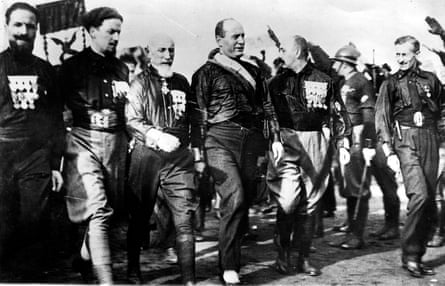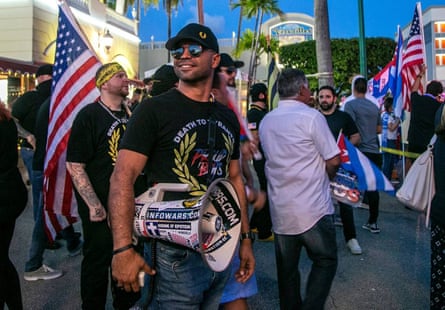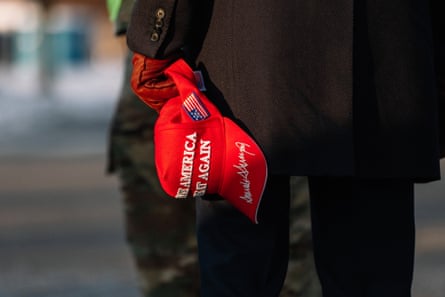Fascism is back in style. Forget the old symbols: swastikas, nooses, Confederate flags, skinheads’ shaved heads and combat boots. Extremism has a new look, and it is as fashionable as ever.
Today’s extremist styles are more diverse and more subtle. Beyond T-shirts that advertise blatant racism, polo shirts with coded symbols create a shared in-group identity and signal support of violence to other believers. Tradwife-style prairie dresses and beauty regimens promote conservative visions of family. Clothing is a powerful tool to spread fascist ideas to promote authoritarianism and recruit new members to this cause.
The far right’s weaponization of fashion to advance hateful ideas is not new. Fascist movements have long understood the power of aesthetics. In 1920s Italy, Benito Mussolini harnessed black shirts and the ancient Roman symbol of the fasces (a bundle of sticks with an axe, which stands for power and authority) to build his power and his brand. German clothier Hugo Boss, a card-carrying Nazi, designed the uniforms of the Schutzstaffel (SS) paramilitary and the Hitler Youth. Hate came with a slick, tailored look. In the US, the white robes of the Ku Klux Klan and burning crosses have long been trademarks of white supremacy. In the 1980s, the original fascists’ skinhead successors appropriated and repurposed bomber jackets, shaved heads and combat boots as their distinct form of military-ish chic.

Now, welcome to fascist fashion 3.0. The aesthetics of modern-day extremists are far reaching and mainstream. Even more so since 2017 and the “Unite the Right” rally in Charlottesville, Virginia, fascist fashion – or fascion (an amalgam of “fashion” and “fascism”) – is now at your fingertips. Right-wing groups have their own labels, co-opt pre-existing fashion brands and hawk their wares online via TikTok and eBay.
Much of this ideological apparel can evade notice – if you are not in the know. Instead of blunt hate-filled slogans, the far right uses language like “my favorite color is white” and “defending our culture” – vague messages that could be interpreted in different ways and offer plausible deniability (however tenuously, because who is the “we” and what “culture” is under siege and in need of protection? And nationalist rhetoric has long been a favorite tool of the right).
Coded visual elements and references are instrumental to conveying the message, to those who know how to read it. Use of specific fonts associated with the Nazi regime, like Fraktur, or those that look faintly Germanic – with dark, peaked letters – help groups to embed their ideology in what seems like innocent slogans or visual cues.
Sometimes, the references come from other cultures or subcultures; today’s reactionaries reference Nordic symbols and imagery of “Valhalla”, as a nod to an imaginary past of white, hypermasculine Europe (FBI director Kash Patel’s recent promise to see slain conservative activist Charlie Kirk in Valhalla raised eyebrows). Gaming memes such as “Pepe the Frog”, which the alt-right has appropriated to convey antisemitic sentiments, also find their way into clothing.
Sometimes the messages are even more coded. A T-shirt at a Nationals game with the number 88 and the word “nationalist” above it might not draw attention, but the combination is a celebration of a neo-Nazi sentiment (88 is a well-known white supremacist numerical code for “Heil Hitler”; the letter “h” is the eighth letter of the English alphabet, and repeating it twice references the infamous salute).
This new fashion no longer seeks to shock or to antagonize, but to appeal to a sense of identity and belonging, said Monica Sklar, associate professor of textiles, merchandising and interiors and curator of the Anne Barge Historic Clothing and Textiles Collection at the University of Georgia. “The idea is not being quite a subculture but to be embedded in the power structure. Instead of coding things to move away from the masses, this fashion is coding things to move into the masses,” and this is a purposeful shift.

Take, for example, a black polo shirt with white stripes at the hems of the sleeves and collar from the activewear brand Will2Rise. It is sold under the name “3.0 Perry Polo”, a reference to the famous British brand Fred Perry, whose black and yellow design was “hijacked” by the far-right group Proud Boys since its founding in 2016. (In 2020, Fred Perry discontinued the model as a result). In the Will2Rise version, Fred Perry’s logo of golden laurels is replaced with a modern design of the white supremacist Patriot Front logo, which depicts an upright fasces surrounded by a circle.
While valorization of masculine power and fitness is an important part of this new aesthetics, women – who are traditionally associated with fashion and adornment – also have a role in shaping the look. Adhering to traditional ideas of gender, the new Republican look of extreme plastic surgery and heavy makeup combines with tradwives’ 1950s dress silhouettes of cinched waists and flowery patterns to celebrate hyperfemininity.
These styles not only allow their wearers to blend in, but they also play a role in normalizing an aesthetics of radicalism and violence. Sociologist and American University professor Cynthia Miller-Idriss, who studies extremism and polarization, has written that “it is simply much harder to recognize ideas as hateful when they come in an aesthetic package that doesn’t fit the image people hold in their heads about what white supremacists look like.” When the radical right looks like the mythical boy and girl next door, it’s hard to know who can be a threat.

But it is exactly this quality that enables extremist fashion to glide into the mainstream. Slogans like “White Life Matters” and other iconography found today on clothing and bumper stickers are reflecting sentiments that started much further to the right. Some of the symbols we see, like an image of a US flag where the stripes are made of machine guns, originated in the militia movement. By the time these items are circulating in the market, the message has been repackaged and toned down by a hair, but the ideas behind the symbols are the same.
This is all part of the fashion cycle.
To be sure, not every conservative or offensive outfit is fascist. Indeed, the lines between hate speech and hyperpatriotism can be blurry. As Sklar points out, “in the US, subcultural dress is much subdued, much more piecemeal,” and thus harder to define or recognize. Moreover, the wearer of these more mainstream, watered-down versions of fascist messages is not always aware of their extreme origins. However, sometimes, this fashionable choice is deliberate, and the decision of whether to expose it as such can entail great risks.
To make things more complicated, as more extreme fashions migrate into the mainstream, we are becoming more desensitized to the ideas they represent. Fascism becomes a selling point with a commercial value. The Florida GOP is selling “Alligator Alcatraz” merch without fear of censure. If only a few years ago appealing to racist sentiments might have brought serious public backlash, today campaigns such as Sydney Sweeney’s American Eagle jeans promotion only bring more attention to the company. Even Charlie Kirk’s death became an opportunity; some companies are branding his assassin’s T-shirt as the “Charlie Kirk Land of the Free T-Shirt.”

Fashion is not static. It changes all the time. What used to be in the margins a few years ago are now on trend. Brand identity can also shift. While in 2020, a Maga hat or a tradwife aesthetics would not be registered as fascist, by 2025, with Trump’s actions and statements becoming increasingly more authoritarian, those styles gain new meaning.
Moreover, the Trump administration’s adoption of not only the Maga styles but those of the far right, aids in the shifting of the brand. Secretary of defense, Pete Hegseth, wears tattoos that are associated with white supremacy. When Ice agents storm the streets of big cities with their ski masks, bullet-proof vests, and khakis, they often look more like the Patriot Front or the Three Percenters militia than representatives of the government.

But this new visibility also makes it easier to expose the fascism and contradictions behind all the freedom talk. Homeland security secretary Kristi Noem’s impeccable curly hair extensions and heavy makeup has earned her the nickname “Ice Barbie”. Her appearance came to define the cruelty of the administration’s immigration policies. As more people associate certain fashions and symbols with actions and policies they oppose, the less appealing they become.
Like we learned to recognize the more traditional fascist symbols, we are now learning to identify the new visual language of the right. In 1935, Sinclair Lewis warned in his novel, It Can’t Happen Here, that when fascism comes to the US it won’t look like the European brand. Instead, it would be wrapped in a flag and carrying a cross. In 2025, we also know that it wears a Maga hat and an Ice vest.

 German (DE)
German (DE)  English (US)
English (US)  Spanish (ES)
Spanish (ES)  French (FR)
French (FR)  Hindi (IN)
Hindi (IN)  Italian (IT)
Italian (IT)  Russian (RU)
Russian (RU)  5 hours ago
5 hours ago
























Comments